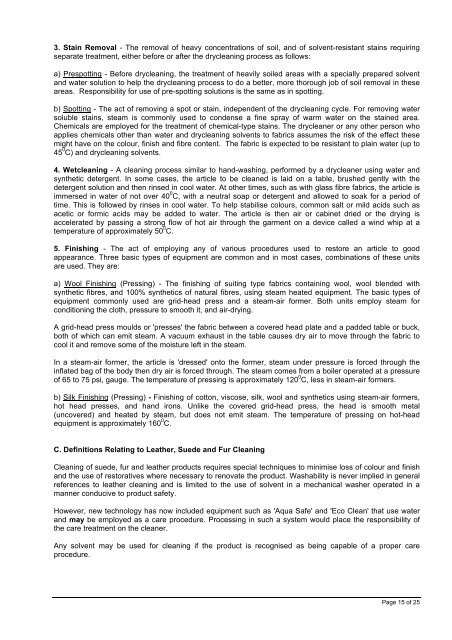international fair claims guide for consumer textiles products
international fair claims guide for consumer textiles products
international fair claims guide for consumer textiles products
You also want an ePaper? Increase the reach of your titles
YUMPU automatically turns print PDFs into web optimized ePapers that Google loves.
3. Stain Removal - The removal of heavy concentrations of soil, and of solvent-resistant stains requiring<br />
separate treatment, either be<strong>for</strong>e or after the drycleaning process as follows:<br />
a) Prespotting - Be<strong>for</strong>e drycleaning, the treatment of heavily soiled areas with a specially prepared solvent<br />
and water solution to help the drycleaning process to do a better, more thorough job of soil removal in these<br />
areas. Responsibility <strong>for</strong> use of pre-spotting solutions is the same as in spotting.<br />
b) Spotting - The act of removing a spot or stain, independent of the drycleaning cycle. For removing water<br />
soluble stains, steam is commonly used to condense a fine spray of warm water on the stained area.<br />
Chemicals are employed <strong>for</strong> the treatment of chemical-type stains. The drycleaner or any other person who<br />
applies chemicals other than water and drycleaning solvents to fabrics assumes the risk of the effect these<br />
might have on the colour, finish and fibre content. The fabric is expected to be resistant to plain water (up to<br />
45 0 C) and drycleaning solvents.<br />
4. Wetcleaning - A cleaning process similar to hand-washing, per<strong>for</strong>med by a drycleaner using water and<br />
synthetic detergent. In some cases, the article to be cleaned is laid on a table, brushed gently with the<br />
detergent solution and then rinsed in cool water. At other times, such as with glass fibre fabrics, the article is<br />
immersed in water of not over 40 0 C, with a neutral soap or detergent and allowed to soak <strong>for</strong> a period of<br />
time. This is followed by rinses in cool water. To help stabilise colours, common salt or mild acids such as<br />
acetic or <strong>for</strong>mic acids may be added to water. The article is then air or cabinet dried or the drying is<br />
accelerated by passing a strong flow of hot air through the garment on a device called a wind whip at a<br />
temperature of approximately 50 0 C.<br />
5. Finishing - The act of employing any of various procedures used to restore an article to good<br />
appearance. Three basic types of equipment are common and in most cases, combinations of these units<br />
are used. They are:<br />
a) Wool Finishing (Pressing) - The finishing of suiting type fabrics containing wool, wool blended with<br />
synthetic fibres, and 100% synthetics of natural fibres, using steam heated equipment. The basic types of<br />
equipment commonly used are grid-head press and a steam-air <strong>for</strong>mer. Both units employ steam <strong>for</strong><br />
conditioning the cloth, pressure to smooth it, and air-drying.<br />
A grid-head press moulds or 'presses' the fabric between a covered head plate and a padded table or buck,<br />
both of which can emit steam. A vacuum exhaust in the table causes dry air to move through the fabric to<br />
cool it and remove some of the moisture left in the steam.<br />
In a steam-air <strong>for</strong>mer, the article is 'dressed' onto the <strong>for</strong>mer, steam under pressure is <strong>for</strong>ced through the<br />
inflated bag of the body then dry air is <strong>for</strong>ced through. The steam comes from a boiler operated at a pressure<br />
of 65 to 75 psi, gauge. The temperature of pressing is approximately 120 0 C, less in steam-air <strong>for</strong>mers.<br />
b) Silk Finishing (Pressing) - Finishing of cotton, viscose, silk, wool and synthetics using steam-air <strong>for</strong>mers,<br />
hot head presses, and hand irons. Unlike the covered grid-head press, the head is smooth metal<br />
(uncovered) and heated by steam, but does not emit steam. The temperature of pressing on hot-head<br />
equipment is approximately 160 0 C.<br />
C. Definitions Relating to Leather, Suede and Fur Cleaning<br />
Cleaning of suede, fur and leather <strong>products</strong> requires special techniques to minimise loss of colour and finish<br />
and the use of restoratives where necessary to renovate the product. Washability is never implied in general<br />
references to leather cleaning and is limited to the use of solvent in a mechanical washer operated in a<br />
manner conducive to product safety.<br />
However, new technology has now included equipment such as 'Aqua Safe' and 'Eco Clean' that use water<br />
and may be employed as a care procedure. Processing in such a system would place the responsibility of<br />
the care treatment on the cleaner.<br />
Any solvent may be used <strong>for</strong> cleaning if the product is recognised as being capable of a proper care<br />
procedure.<br />
Page 15 of 25


